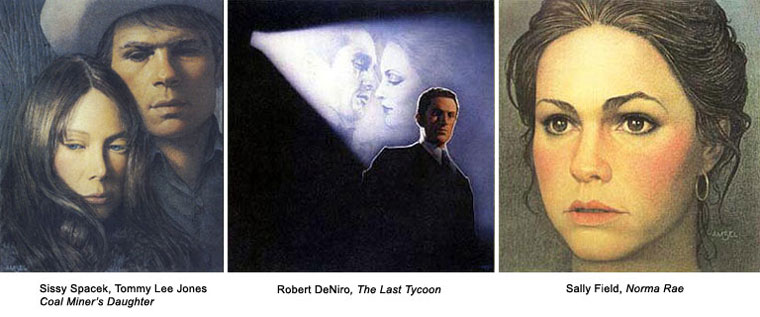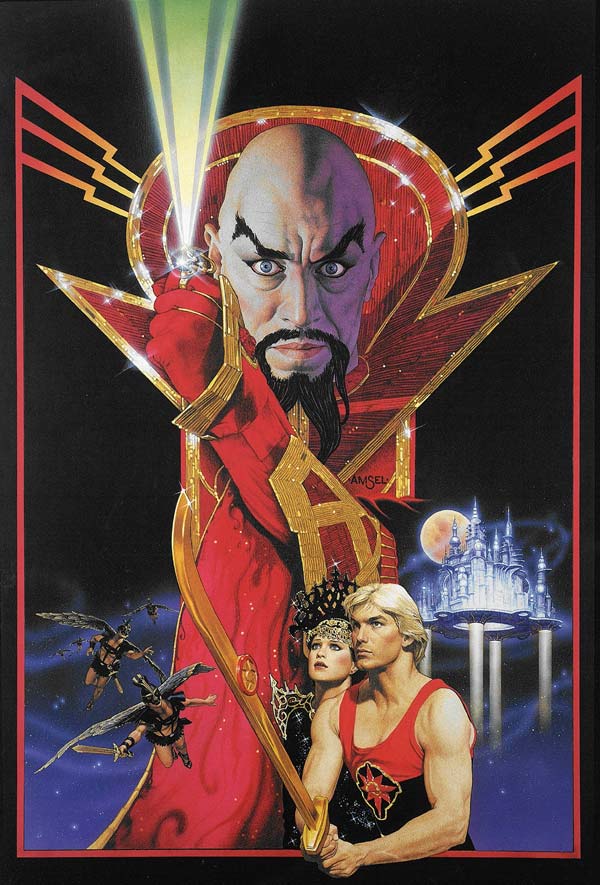Articles
Amsel: Illustrator of the Lost Art by Stephen Jared
 Harrison Ford, Raiders of the Lost Ark Harrison Ford, Raiders of the Lost Ark |
My generation's first ever look at Indiana Jones was through the eyes of Richard Amsel. I was thirteen when Raiders of the Lost Ark was released. I had some minor talent with drawing, and after seeing the film, I penciled many copies of the initial Amsel poster. I kept getting frustrated because I would always make the body of Indiana Jones too big. Eventually, I realized I was doing this because it's what Amsel had done. David Hockney said that a photograph can only tell you what something looks like but a painting can give you the experience of the thing. Maybe this is why Amsel's interpretation of Indiana Jones only looks odd if closely examined. The large body makes Indiana Jones seem indestructible, and that's accurate to our experience with him. Had Amsel seen the film prior to painting the poster? Probably not. But he likely had a synopsis or verbal description of the story, details about the character. He knew Indiana Jones would dodge death countless times before the closing credits.
Illustrated movie posters like these are now largely a thing of the past. Thus, the title of Adam McDaniel's currently filming documentary, Amsel: Illustrator of the Lost Art. The decline of poster art is a tragic loss, especially considering recent films like The Legend of Tarzan or John Carter, movies that screamed for great illustrated posters and never got them. Movie posters can be more exciting than trailers because trailers are simply a short montage of what audiences will eventually see but an illustrated poster exists separate from the film. At its best, an illustrated poster tells you what the film feels like, and as with any painting, the entirety of it can be experienced in an instant, whereas a movie, like a book or piece of music, requires time.
 |
Amsel was born in Philadelphia in 1947. While attending the Philadelphia College of Art he won a nationwide poster competition 20th Century-Fox sponsored for their new release, Hello Dolly, starring Barbara Streisand. Shortly thereafter, he moved to New York, had an extraordinary career that lasted fifteen years, and then at the age of thirty-seven he died from AIDS.
 |
Given his tragically short life and career, his accomplishments are even more remarkable, not just in the quality of individual works but in the variety of styles as well. Influences aren't too difficult to spot. Mostly we see Norman Rockwell's earthy, rustic, weathered surfaces and Alphonse Mucha's densely outlined ringlets and waves. It's somewhat noteworthy that Mucha's first artistic success came from designing a poster advertising a play, which featured Sarah Bernhardt, the most successful actress in 1890s Paris.
It's always tempting to seek something personal in an artist's work. Of course, everything an artist does offers some insight into the person, some autobiography. Occasionally, Amsel leaned toward portraits of haunted characters. In these instances, he transcends the celebrity persona he captures. He transcends advertising, and reveals an artist with great depth of feeling.
 Michael Douglas, Kathleen Turner, The Jewel of the Nile Michael Douglas, Kathleen Turner, The Jewel of the Nile |
When he died, Amsel was working on The Jewel of the Nile. He never finished it. The surviving sketches offer sad glimpses of what could have been. Thankfully, Amsel's work has outlived him, but keeping any artist's legacy alive requires effort. In addition, his personal story is one that should be told. Adam McDaniel is deserving of enormous gratitude for taking on this project. He's put many years of research into it. A more compassionate and generous tribute to Amsel could be made by no one. I can't wait for you to see it.
Stephen Jared, Associate Producer
For more information on the documentary, please visit:
 Sam Jones, Max von Sydow, Flash Gordon Sam Jones, Max von Sydow, Flash Gordon |
Click images to view larger versions.


